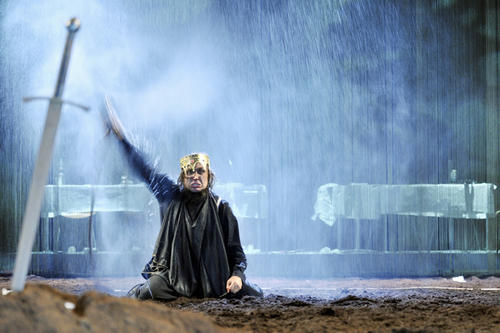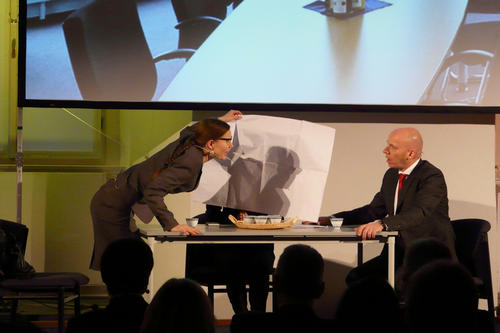Solving Problems through Acting
As therapy, a hiring test, or for conflict resolution: Applied theatre is becoming more important.
Oct 04, 2013
Applied theatre: Even back in his day, Hamlet – played here by Lars Eidinger in a production by Thomas Ostermeier at Berlin’s Schaubühne – hoped to use a theatrical piece to catch his father’s murderer at the Danish court.
Image Credit: Arno Declair
Today as well, acting is a means to an end: Actors performing at Berlin’s corporate theater Inszenio.
Image Credit: Fabian Lempa
Art and functionality – it’s not generally considered a fortunate combination. The demand for aesthetic autonomy, which first became popular around 1800, still exerts a huge influence on artists and audiences.
And yet, recent decades have seen an increase in the popularity of new forms of theatre that could not be less focused on striving for beauty for its own sake: Companies use role playing to test applicants’ communication skills, trauma patients process their experiences through acting exercises, students discover their creativity in drama workshops. These and other forms of “applied theatre” are the subject of research in the project “The Aesthetics of Applied Theatre,” headed by Matthias Warstat, a professor of theatre studies at Freie Universität Berlin.
Warstat has received a major grant for his project. The European Research Council (ERC) is providing just under 2.3 million euros for the project over a term of five years. “The field of applied theatre has not been researched very much in theatre studies; so far, it has been mostly education scholars or sociologists who have studied these forms of theatre,” Warstat explains.
The research team, which currently consists of four doctoral candidates and four postdocs, will spend the next few years studying the performance situations and representational forms of applied theatre in various countries and comparing them with theatre arts. Warstat had the idea for the project while he was working on his habilitation, the postdoctoral qualifications generally required to work as a professor in Germany. “I was working on the effects promised by avant-garde theatre in the 20th century, meaning goals such as building community, raising political consciousness, and therapy. In this project, we now have the opportunity to consider the present day and do field research.”
The group’s research is divided into four areas: Theatrical Education, Theatre in Areas of Conflict, Theatre as Therapy, and Corporate Theatre. For example, one subproject under way in the area of Theatrical Education is dedicated to various cultural initiatives in Mexico City that aim to open up new perspectives for socially disadvantaged youth and thereby fight everyday violence. One topic in the “Theatre in Areas of Conflict” subproject is how the Israeli-Palestinian conflict affects theatre in that region.
Within the Corporate Theatre field, a doctoral candidate is making contact with companies that use theatre at their assessment centers. “In these cases, applicants are asked to participate in role-playing exercises to demonstrate their communication skills,” Warstat says. One common exercise is a conversation between a boss and an employee whose performance leaves something to be desired. One of the two roles is usually played by an actor who has had plenty of time and material to prepare, while the applicant has to spontaneously think up a strategy to defend his or her point of view – a major challenge.
“The functionalization of theatre is especially apparent in this area. For those of us who study theatre, how those who provide corporate theatre see themselves is especially interesting,” Warstat explains. The definition of what they do, he says, varies widely, with some actors viewing themselves as service providers and some as artists.
While those participating in an assessment center are looking to land a job, therapeutic theatre has to do with a higher aim: mental health. “During trauma therapy, patients use theatre to learn how to create distance between themselves and their experiences. They might act out scenes of conflict taken from Greek tragedies that are somehow associated with their own traumatic experiences, but are not actually their own,” Warstat says. The protected space that theatre offers helps patients to process their experiences.
In the background for the various research projects, there is always the question of the extent to which the growing importance of applied theatre has to do with overcoming social problems. For one thing, it’s an issue of financing, Warstat says. “If you have a certain issue in mind, it’s significantly easier to get money from the government or other organizations. In Germany, that means theatre education is becoming more and more important. In some African countries, applied theatre such as that used for AIDS prevention is the most widespread subsidized form of theatre.”
For another thing, he says, there is also a thesis of “performativization” of society in the field of theatre studies. “Having to present yourself publicly, sell yourself, reinvent yourself – these things are on the rise in every area of our lives. And these are precisely the kinds of activities that are characteristic of theatre.”
In this view, applied theatre meets the needs of our times. Still, Warstat and his fellow researchers view the increasing importance of this kind of theatre with some skepticism. “Theatre is becoming the tool of a social development that is not unproblematic, and that is something else we need to come to grips with.”
Further Information
Professor Matthias Warstat, Freie Universität Berlin, Institute of Theater Studies, Email: matthias.warstat@fu-berlin.de


